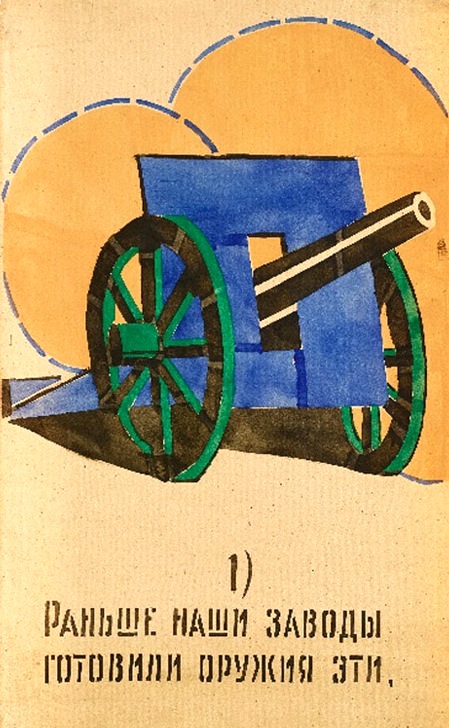In a situation in which museums, put under pressure by the market, are increasingly withdrawing from their core business of basic historical research on the state of present-day art, it can happen that precisely in this regard they are overtaken by extraordinary initiatives of the market itself, by galleries, for instance, which are now taking charge of establishing a necessary critical discourse. The gallerist Thomas Flor in Berlin is now doing so with the exhibition of an equally legendary and hard-to-classify key project of the classical avant-garde, the so-called ROSTA windows from revolutionary times in Russia. These bright and colourful pictorial messages form a peculiar interface between elitist modernist aesthetics, popular illustration graphics, state propaganda and communicative guerrilla techniques. The pressing question as to an historical connection between the two antagonistic views of art, the formalistic ideal of autonomy, which was constitutive in establishing the art market in the post-war era, and a subversive, interventionist practice, is posed anew in this show.
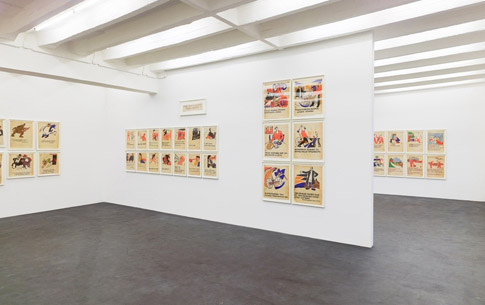
ROSTA, exhibition view, Gallery Thomas Flor, Berlin 2014 (14 posters, handmade with stencils, each 41 x 51 cm)
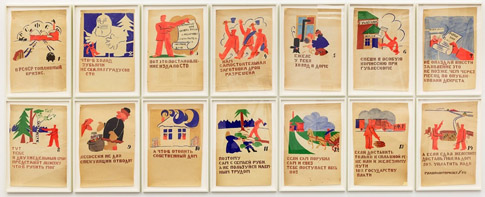
ROSTA-Collective, GPP 223, Juli 1921 (14 posters, handmade with stencils, each ca. 41 x 51 cm)
ROSTA was the news agency of the Bolsheviks, founded shortly after the October Revolution. In February 1919, the painter and caricaturist Mikhail Cheremnykh in collaboration the journalist Nikolai Ivanov started an artistic campaign in the shop window of an empty confectionery with a visually designed news agency report. The campaign was to last three years, from the devastating period of the civil war to the introduction of a rudimentary market economy. The initiative was taken up a few weeks later by the popular revolutionary poet Vladimir Mayakovsky, who had recently caused a stir with the publication of an anthology of his futuristic poems and the performance of an elaborate satire spectacle, the “Mystery Bouffe”. When passing by one of Cheremnykh’s ROSTA windows, it seemed he immediately grasped the potential of the initiative. If one can believe his own accounts and those of his hagiographer, Mayakovsky soon functioned alongside Cheremnykh as the spiritus rector of a constantly growing illustrated news collective.

Vladimir Mayakovsky (Source: Wassili Katanian, Majakowski, Moskau 1930)
The project was support with great effort by Platon Kerzhentsev, the new director of ROSTA. Kerzhentsev was one of the driving forces of the avant-garde Proletkult organization, whose aim was to establish an autonomous working-class culture leaving all traditional, bourgeois genres behind. The revolutionizing of expression, which Proletkult had hitherto sought mainly in the field of literature and theatre, could now be applied under the aegis of Mayakovsky to the area of graphic picture publishing as well. Mayakovsky selected the ROSTA news items and prepared them along with other poets and journalists for pictorial realisation. “The field of activity was huge: advertising work for the Comintern and for collecting mushrooms in the interest of those suffering from hunger, the battle against Wrangel and the typhus lice, posters requesting to keep old newspapers and posters advocating electrification.”[1] He gave many of the reports rendered in compact verses to befriended artists such as Ivan Andrevich Maljutin, Amshey Nurenberg, Viktor Deni, Alexander Rodchenko and Mikhail Volpi, who had meanwhile joined the collective.[2] Together with Cheremnykh, Mayakovsky was responsible for a large part of the ROSTA graphics. He estimated his portion of the enormous overall production to be 3,000 drafts and 6,000 captions.[3]
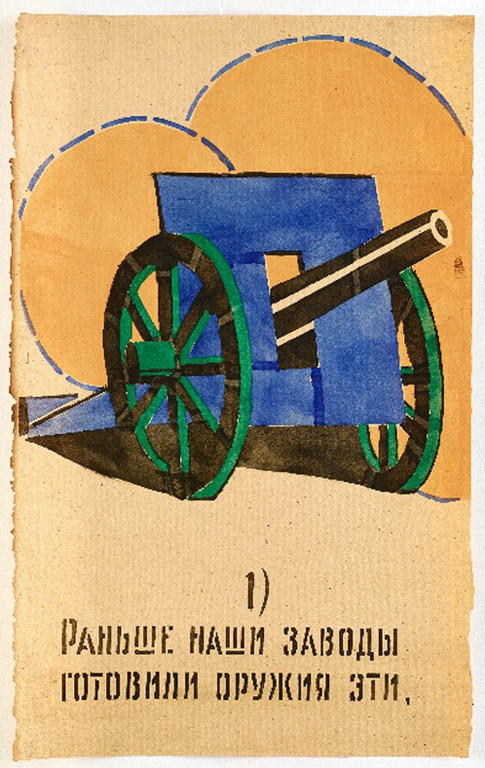
ROSTA-Collective, GPP 81-1, März 1921
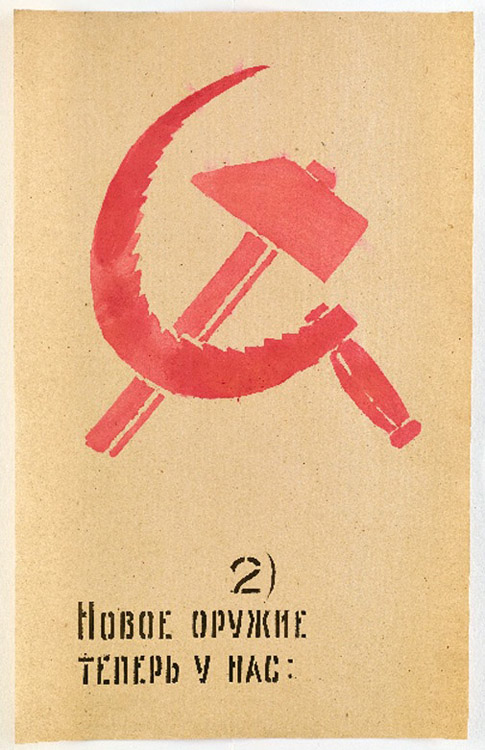
ROSTA-Collective, GPP 81-2, März 1921
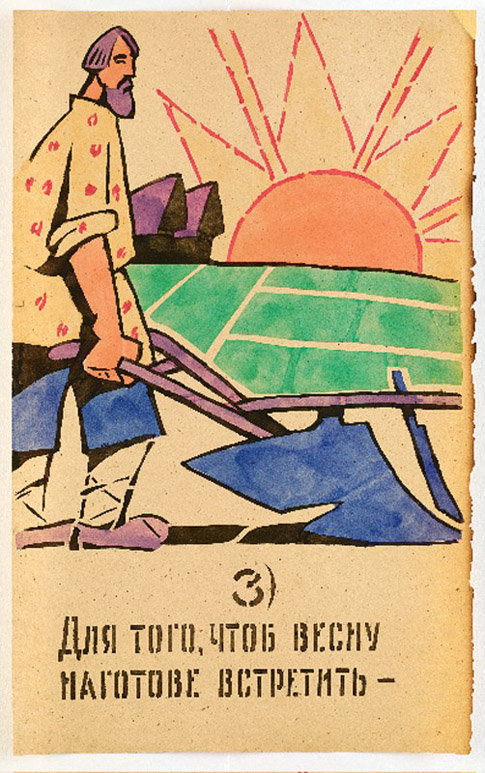
ROSTA-Collective, GPP 81-3, März 1921
Although the attribution of the unsigned posters to individuals contradicts the collective intention of the project and is not even possible in an unambiguous way, several distinguishing features can be detected. For example, Cheremnykh’s works, estimated to amount to one third of the entire production, reveal the professional cartoonist on account of their dynamic handwriting and catchy picture ideas. Nurenberg’s posters make an equally virtuoso impression, but they are more reserved and richer in detail. Mayakovsky’s style is particularly noticeable. The minimalist figurations come close to pictograms; his planimetric style seeks loud colour contrasts, while his posters appear more playful and incoherent than those of his professional graphic artist colleagues. Most of the windows displayed by Thomas Flor reveal his and Cheremnykh’s handwriting.
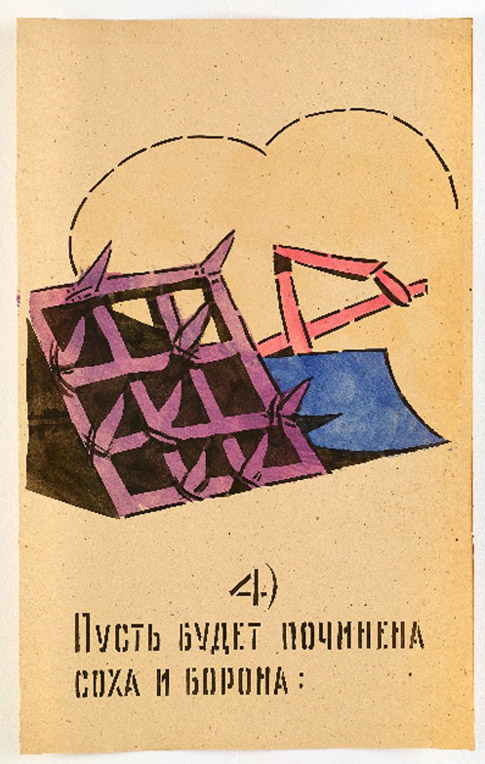
ROSTA-Collective, GPP 81-4, März 1921
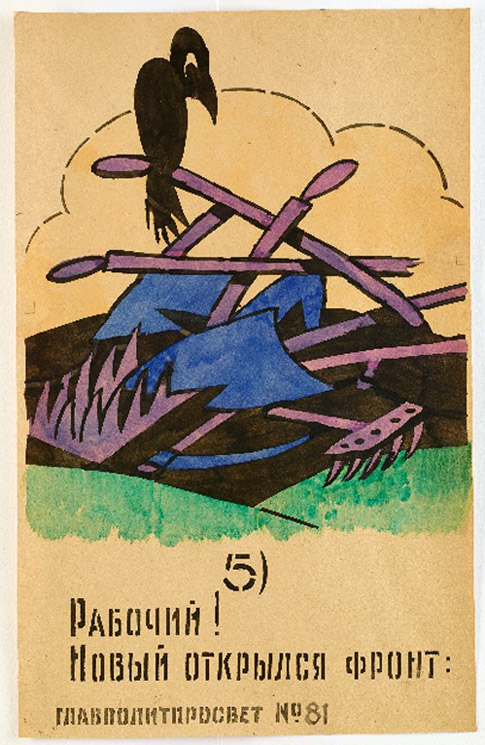
ROSTA-Collective, GPP 81-5, März 1921
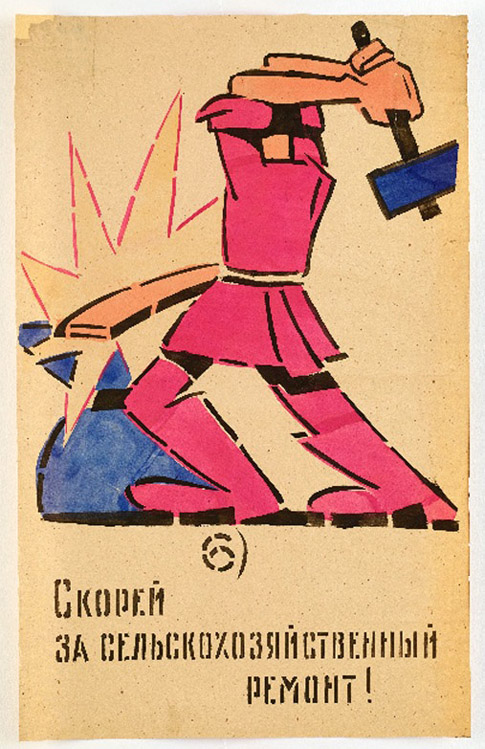
ROSTA-Collective, GPP 81-6, März 1921

The first posters exclusively addressed the Muskovite public, but the distribution frame and size of the collective quickly expanded. Since there was no functioning printing shops and a lack of paper, the first posters were traced in small editions, later a system of manual reproduction with stencils was established, modelled on the Pochoir culture of the French caricature movement and an early form of screen printing. “The technique of reproducing and sending the windows took place in a flash,” Cheremnykh recalls. “After receiving the original, the stencil-maker had already completed 25 copies the next day, 50 more on the second day, and after a few days he had completed the entire edition, around 300 copies. The stencil-maker usually worked with his family or a small collective.”[4] Even the most sophisticated printing methods could not compete with this manual method as far as the brilliance of the colour effects was concerned. In his memoirs from 1930, Mayakovsky states that ROSTA was a “fantastic thing”, since it “meant serving a little populace of 150 million by a handful of artists.”[5] The reproduced poster series – usually thematic sequences of 4 to 14 prints – were sent to all parts of the country, where they were displayed in tableaux-like sequences.
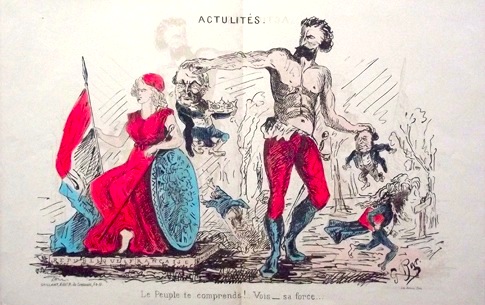
Stencil-coloured graphic of the Parisian Commune by G. Bar, 1871 (MePri-Coll.)
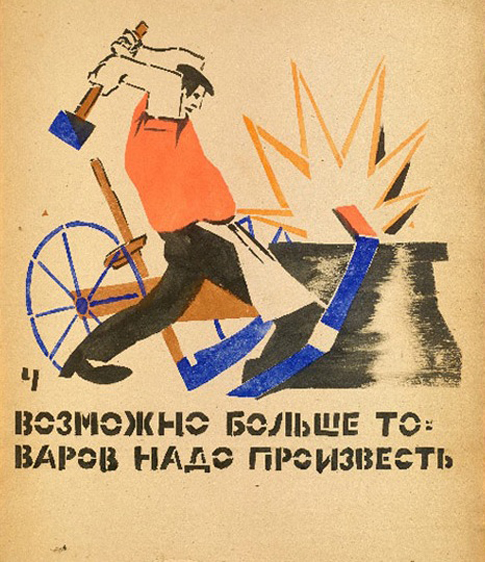
ROSTA- Collective , GPP 213-4, Mai 1921
The prerequisite for reaching as much of the mostly illiterate population as possible was to develop a more or less consistent pictorial sign system. The grammar of pictograms established by the ROSTA collective over time is a novelty in the history of illustration. It had a decisive impact on the development of modern infographics.[6]
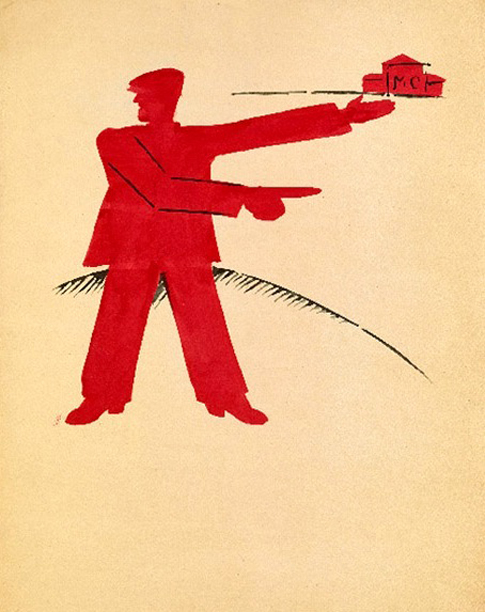
ROSTA- Collective (Mayakovsky), , GPP 352-1, September 1921
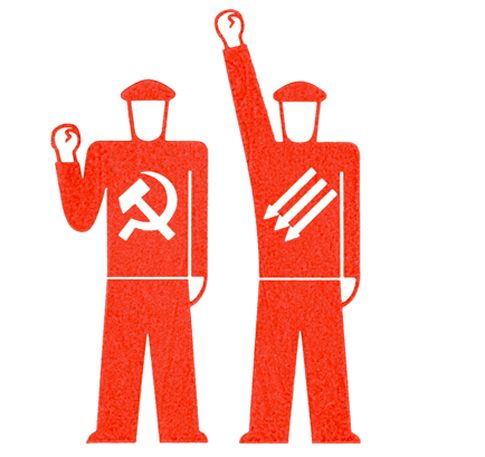
Gerd Arntz, Isotypie (ca. 1940) (https://www.gerdarntz.org/)
ROSTA’s compact picture language can be ascribed to a number of different factors. On the one hand, they were of a technical and organisational nature and had to do with an intoxicating production speed that had to keep up with the rush of news. “It occurred that the telegraphic report of a victory at the front was already displayed as a coloured poster on building walls within forty minutes to an hour.”[7] Rapid stencil reproduction also demanded a formal language that was as reduced as possible. And, of course, the primitivist ideal of the classical avant-garde also played a role. What was explicit in the case of ROSTA was the reference made to the rustic Russian popular prints, the lubok woodcuts. The crude text-image combinations of the lubki were the structural model of the windows. As opposed to Kandinsky’s formalist interest in the lubok, which had a folkloristic-mystical background, the ROSTA artists were concerned with the communicative content, for in the archaism of the depictions the old picture prints also addressed the illiterate majority of the population. Mayakovsky had gained relevant experiences in the field of pictorial propaganda already at the beginning of the first World War when he designed together with Kazimir Malevich and other futuristic artists series of lithographic caricature-like posters for the publishing house Segodnyashny lubok (contemporary lubok) in the traditional lubok- style.
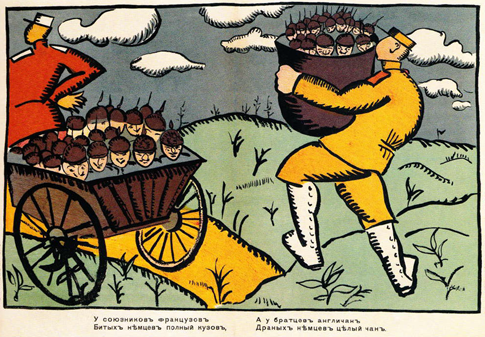
Kazimir Malevich (image) / Vladimir Mayakovsky (text): “The French Allies have a basket full of defeated German soldiers / The English brothers carry a tub filled with tattered German soldiers.” Poster for Segodnyashny lubok, 1914
The fact that the ROSTA graphics were not only obliged to archaism but also stood on the ground of a rich political illustration culture is less familiar. Russia was not a developing country in regard to press graphics. There was a long tradition of critical illustrated journalism that the Czarist regime was able to largely suppress, but that powerfully forged ahead twice. The 1860s, after the fiasco of the Crimean War, experienced a first heyday of Russian pictorial satire. The short but intensive intermezzo was eclipsed in 1905 after the Bloody Sunday of St. Petersburg by a further avalanche of caricatures. More than 400 satirical magazines countered the continuation of the autocratic Czarist regime during the course of the first Russian Revolution.[8] Although this spring of freedom of expression lasted just two years, it did suffice for the emergence of one of the most brilliant graphic milieus of the times and the implementation of the foundations for developing a socialist pictorial language in Russia. Two internationally leading satire magazines had a huge influence, the German Simplicissimus and the French anarcho-artist journal Assiette au beurre with draughtsmen such as Jules Grandjouan, Thomas Theodor Heine, Frantisék Kupka and Théophile-Alexandre Steinlen. Certain features of the ROSTA style, e.g., the tendency towards condensed emblematics and iconic typography or the use of constructivist formal elements, could already be found in a rudimentary form in the first phase of Russian revolutionary graphic art.
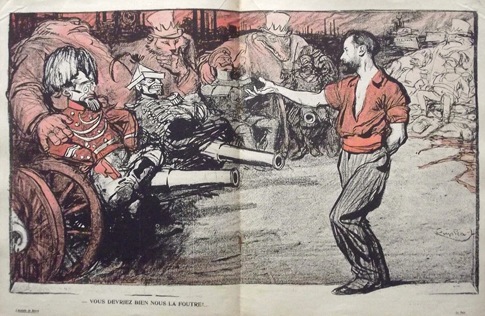
Frantisek Kupka, Assiette au beurre, 1904 (MePri-Coll.)
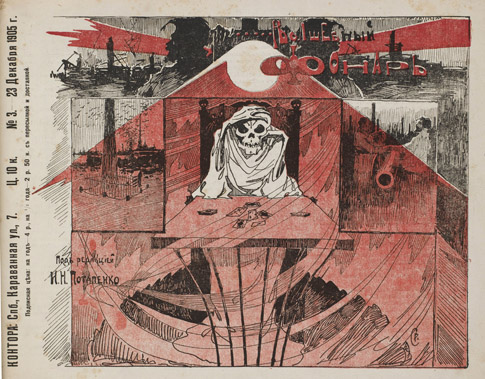
Volshfon, V01-N03, 1905 (USC Digital Library, Russian Satirical Journals)
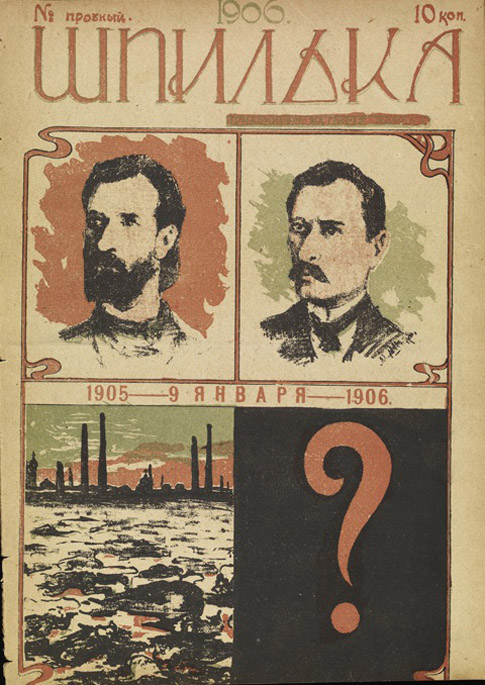
Shpilka,V00-N01, 1906 (USC Digital Library, Russian Satirical Journals)
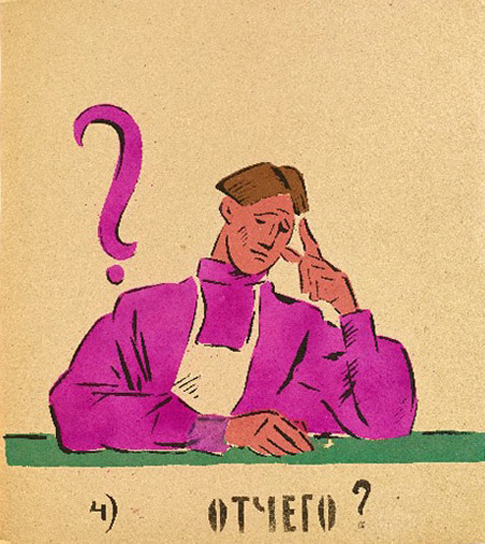
ROSTA- Collective , ROSTA 753-4, Dezember 1920
The second revolution then brought the artistic novelty of Cubo-Futurism’s space-fragmenting perception into play, a commonality of all artists of the ROSTA collective. During this time, the use of avant-garde styles in illustration graphics was already a longstanding practice in the progressive French press. One can assume that the artists of the ROSTA collective were quite familiar with the gaudy, late-Cubist and Cloisonist illustrations of a Jean Cocteau, Juan Gris, Paul Iribe, Gustave Jossot or Felix Vallotton that had appeared in internationally distributed satire papers such as Cocorico, Le Mot or the already mentioned Assiette au beurre.
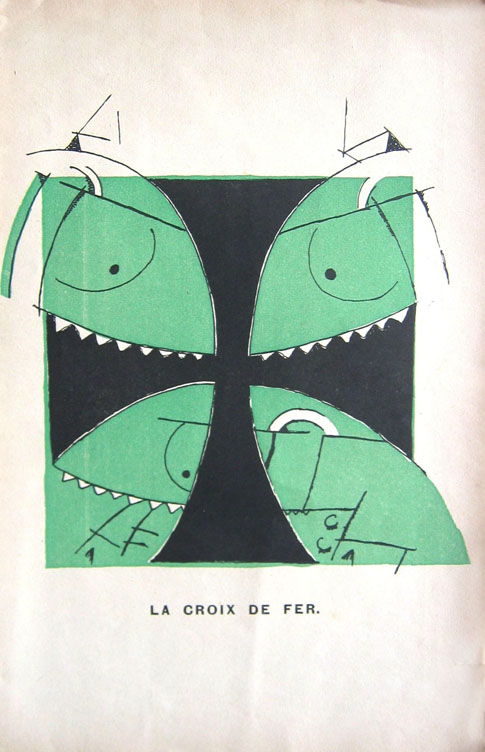
Paul Iribe, in: Le Mot, No. 20, Paris 1915 (MePri-Coll.)
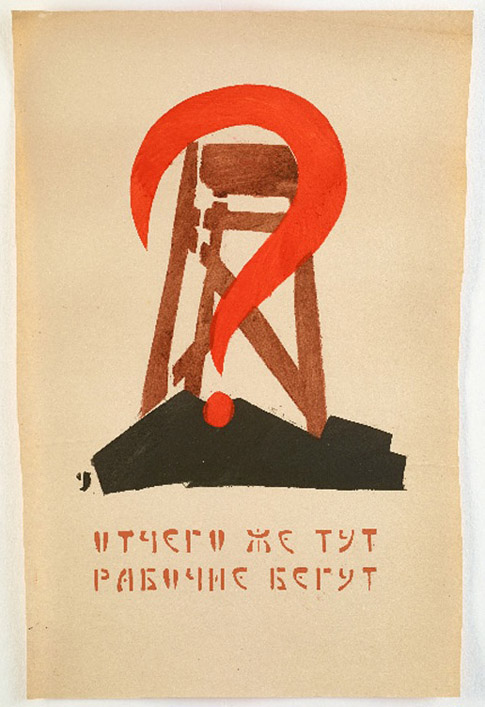
ROSTA- Collective , GPP 331-9, September 1921
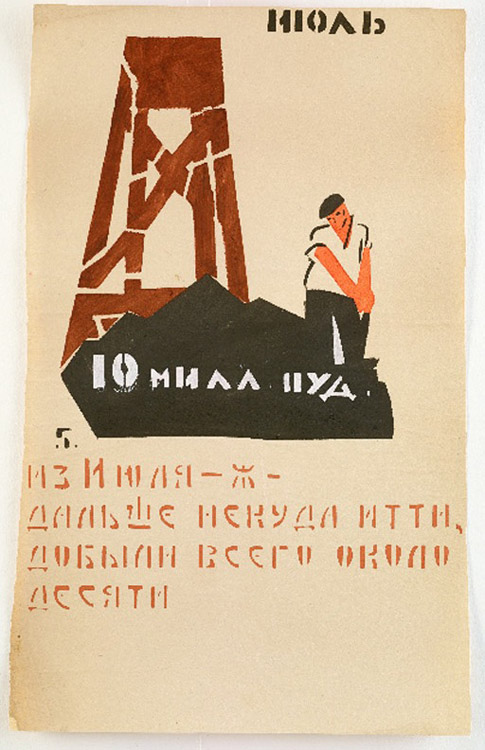
ROSTA- Collective , GPP 331-5, September 1921
The excellent selection that Thomas Flor presents in his show also makes it clear that the stylistic contemporariness of the ROSTA graphics was not limited to an adaptation of the already declining art of the classical avant-garde, but also included the then highly topical culture of American daily strips. Communism and comics were not oppositional camps in the pre-Disney era, quite to the contrary. The slapstick-like funnies with political contents that Ernest Riebe had been drawing since 1912 for the international union movement IWW were very popular in communist circles. Particularly the windows of Mikhail Cheremnykh reveal a conspicuous stylistic proximity to comic cartooning. The world he visualised reminds one more of Coconico Country populated by funny spinach sailors than of a country devastated by civil war, where kolkhoz farmers and Red Guards struggle for their existence. With this synthesis of late-Cubist abstraction and comic style, Cheremnykh created a poster art that appears to have fallen out of time. It shows astonishing parallels to experiments undertaken decades later under entirely different circumstances in the paintings of Jean Hélion and Markus Lüpertz.
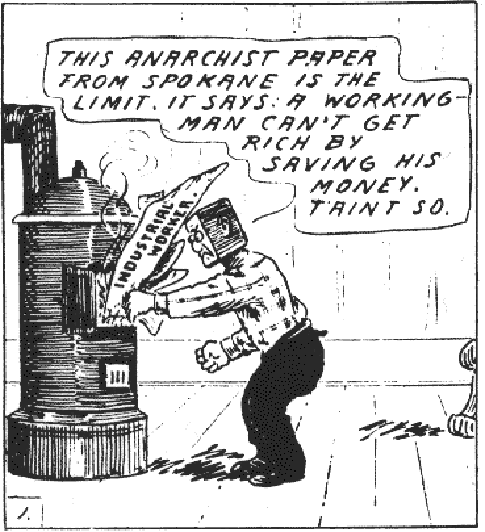
Ernest Riebe, Mr. Block invests his savings, Spokane Industrial Worker, 1912 (www.blunderbussmag.com)
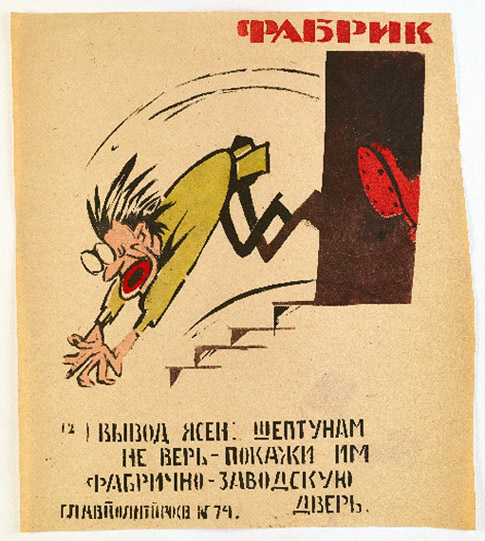
ROSTA- Collective (Cheremnykh), GPP 74-12, März 1921
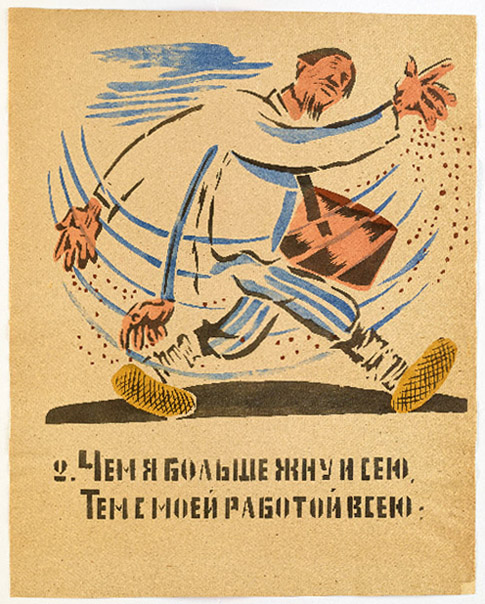
ROSTA- Collective (Cheremnykh), GPP 173-2, April 1921
With the publication of the German translation of Viktor Duvakin’s monograph[9], the ROSTA windows became known in the West in the late 1960s and had quite a bit of influence on the development of the European agitprop culture. Jörg Immendorf’s and Chris Reinecke’s Lidl project, for example, would not have been conceivable without this background.[10] The cultural historical range that ROSTA spans is much broader, though. Mayakovsky’s “day-order to the art army,” that “streets are our brushes” and “squares our palettes,”[11] combined the flashy posters hung in the drab everyday life of the revolution in Moscow with the illuminated display windows of the Parisian publisher Aubert, where in the early 19th century Philipon’s caricature army with its outspoken picture campaigns had invented the heroic worker, undermined the July Monarchy and prepared the February Revolution, and the caustic stencil-coloured satirical posters of the Parisian Commune with the pavement beach of ’68 peppered with posters, with street art and communication guerrilla.
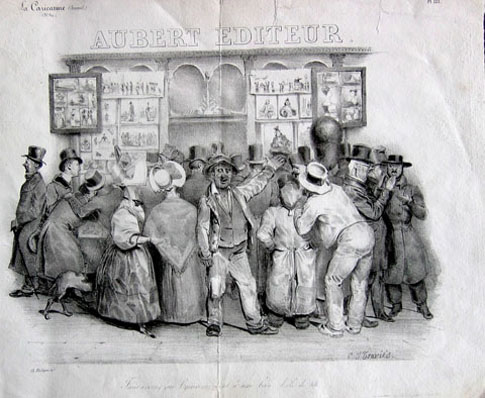
Charles Joseph Travies, Aubert Editeur, 22.12.1831 (MePri-Coll.)
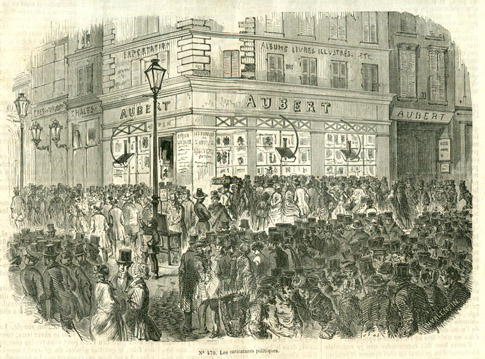
Les caricatures politiques (Philipons Caricature-Windows in the center of the February -Revolution) in: Journees Illustrees de la Revolution de 1848; Paris 1849 (MePri-Coll.)
The campaign at ROSTA ended at the beginning of 1921 with the departure of Platon Kerzhentsev. Afterwards, it was continued for one more year with a stricter conception in didactical terms under the patronage of Glavpolitprosvet (GPP), a newly founded educational institution of the Ministry of Cultural Affairs. The hand-made propaganda picture prints were now outdated. Their woodcut-like rhetoric no longer met the more complex communication demands of the development years and the party also distanced itself more and more from the initiatives of the Futurist avant-garde. Leo Trotzky, who like Lenin was initially not unsympathetic towards the commitment of the artistic avant-garde, registered an unbridgeable divide between the Futurists’ communist initiatives and the mentality of the workers, which in his view was caused by the elitist, bohemian provenance of the art movement.[12] Trotzky’s criticism was also directly aimed at Mayakovsky and his efforts to be at the service of the revolution. It above all raised the question of the extent to which the abstracting picture language is actually accepted by the “little populace of 150 million”, or whether the gesture of primitivism was not instead supported by the unrealistic assumption of a simpleminded proletarian culture.
Mayakovsky at least shared Trotzky’s observation that the proletarian revolution had enormously advanced the development of individualistically constricted Futurism in that it provided for a productive dissolution of boundaries. Mayakovsky mainly held the new practice of illustrated journalism responsible, the intoxicated artistic treatment of day to day events that forcibly gave rise to a “telegraph-like, machine-gun-like speed”. “With it, we also revolutionised artistic taste, enhanced the qualification of poster art and agitation art. If one can speak of a revolutionary style in the art of drawing – then it was the style of our windows.”[13] This revolutionising of artistic taste implied nothing other than a profound revaluation of the ephemeral to art’s highest form of realisation. But that was a promise the classical avant-garde was only able to keep for a short moment. In the subsequent period, it was all too obliged to an ongoing orientation towards conservative values that emerged through the formation of fronts after the Second World War. But the window thus remained open in a new traditionalism of socio-technical art practices that began in the 1960s.
The exhibition ROSTA at Gallery Thomas Flor runs till April 26
(All images ROSTA/ GPP: Courtesy Gallery Thomas Flor, Berlin – Photos: Eric Tschernow)
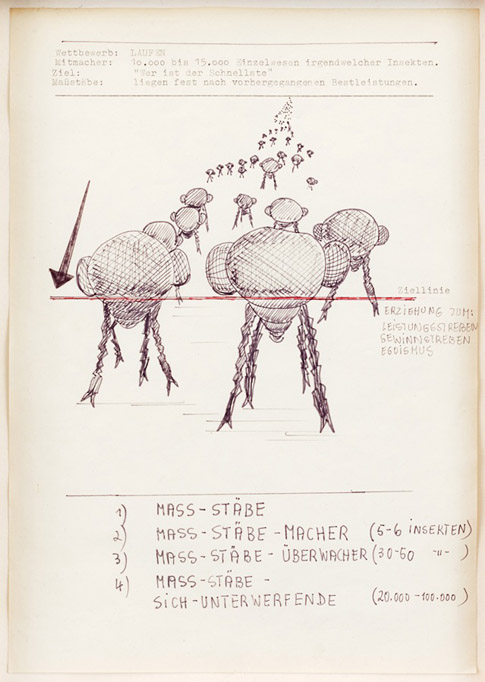
Chris Reinecke: Mass-Stäbe, aus: Schaufenster-Bilder, 1969-71 (Courtesy Galerie Thomas Flor)
Annotations
[1] Krempel Anm. 426 > Majakowski Werke, V, p. 319 f.
[2] During the peak of poster production, the ROSTA collective consisted of more than 100 persons, according to estimates by Viktor Duvakin. (p. 44)
[3] Dickermann, p.8
[4] Cheremnykh, > Duvakin p. 43
[5] Mayakovsky, Ich bitte ums Wort (1930), > Duvakin, p.43
[6] The pioneers of pictorial statistics, Otto Neurath and Gerd Arntz, maintained close ties to Moscow
[7] Mayakovsky, Ich bitte ums Wort (1930), cited after Duvakin, S.66
[8] Krempel p. 105 ff.
[9] published 1967 in Dresden (original edition:1938 in Moskau und Leningrad)
[10] Chis Reinecke with her “Schaufenster-Blätter” (1969-70) inspired the ROSTA-exhibition at Thomas Flor.
[11] Gedicht von Mayakovsky vom 7.12.1918, cited after Duvakin p. 37
[12] Leo Trotzki, Literatur und Revolution, Wien 1924, p. 121
[13] Mayakovsky, Ich bitte ums Wort (1930), cited after Duvakin, p. 66 and Krempel p. 279
Literature
Leo Trotzki, Literatur und Revolution, Wien 1924
Wiktor Duwakin, ROSTA-Fenster. Majakowski als Dichter und bildender Künstler, Dresden 1967 (2. Auflage 1975)
Ulrich Krempel, Die ROSTA-Fenster und ihre Stellung in der Entwicklung einer sozialistischen Bildersprache, Dissertationsarbeit an der Ruhr-Universität Bochum 1975
David King & Cathy Porter, Blood and Laughter: Caricatures From the 1905 Revolution, London 1983
Stephen White, The Bolshevik Poster, Yale Univ. 1988
Div., Die große Utopie: Die russische und sowjetische Avantgarde 1915-32, Frankfurt Main 1992
Div., Victor Deni, ein russischer Karikaturist im Dienst der Propaganda, Hamburg 1992
Leah Dickerman, ROSTA Bolshevik Placards 1919-1921. Handmade Political Posters from the Russian Telegraph Agency, New York 1994
Stephen P. Frank & Mark D. Steinberg ed., Cultures in Flux: Lower-Class Values, Practices, and Resistance in Late Imperial Russia, Princeton 1994
Alex Ward ed., Power to the People: Early Soviet Propaganda Posters in the Israel Museum, Jerusalem 2007
David King, Russian Revolutionary Posters, London 2012
